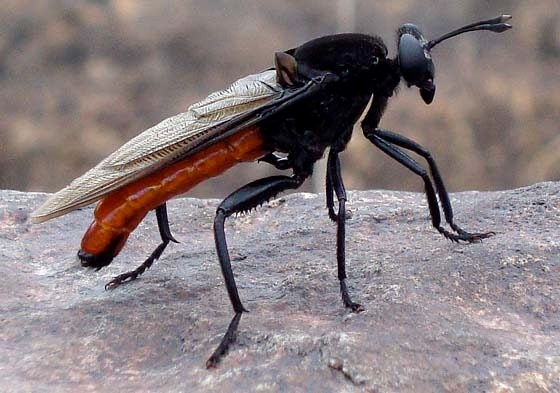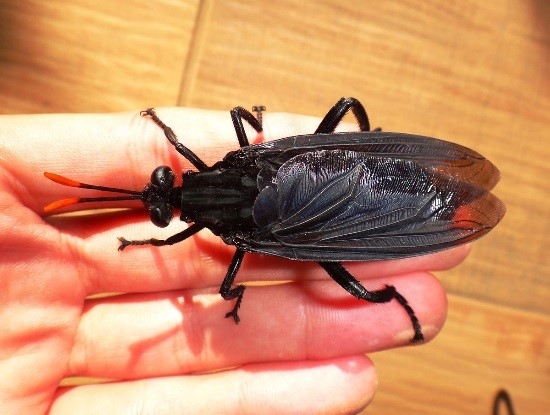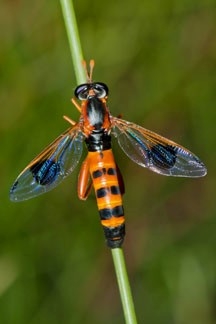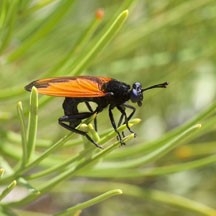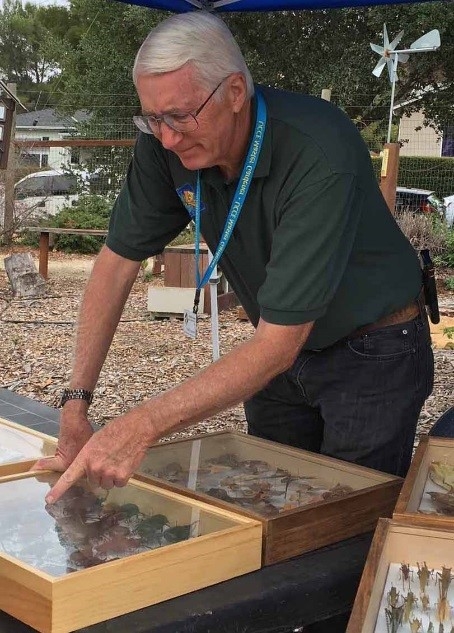- Author: Norman Smith
Youdid, Wedid, Medid, Shedid, Hedid, Mydid?
Mydid Flies, genus Mydas – Good bugs or not so good?
Norm Knows.
By Norman Smith, UC Master Gardener
So, are these good bugs or bad bugs? What do you think they are, wasps or flies? Actually they are considered to be of little consequence, neither good nor bad. They are flies in the family Mydidae, genus Midas. They are mimicking wasps, mostly spider wasps of the family Pompilidae. Their larvae are predacious on beetle larvae that are found in rotting wood or decaying soil. They do not sting and I don't think they bite like their relatives, the robber flies, though I don't think I would test one. As you can tell from the fly sitting on the hand, they can be fairly large.
Of course, most folks who saw these in their yard would consider them to be a wasp, and would leave them alone. That is exactly what they want. And their mimicry is not limited to looking like a wasp. They also fly like one as I found out too late one day while collecting along the Colorado River near Blythe in late spring. I had seen what I thought were Pepsis wasps (Tarantula hawks), flying around the willows along the river. I had plenty of Pepsis wasps in my collection so I did not bother collecting any until late in the morning when I decided I should go ahead and get one just for the locality data. I could not believe what I found in my net - not a wasp but one of these Mydid flies. I was incredulous. A mydid fly, not a wasp? I immediately began looking for more to catch as I knew that Mydid flies were quite rare and not often collected. Alas, I did not get any more, as the temperatures were nearing 90 degrees at 11:00am in the morning and their flight time was over. It was embarrassing to think how badly I had been fooled by these flies, that looked and flew so much like a tarantula hawk. I had probably seen 1/2 a dozen throughout the morning.
The idea for writing about these flies came about late last week while going over a Cal Poly student's insect collection. The young man had mislabeled a fly in his collection as a wasp. It was the mydid fly with the orange abdomen - he had been fooled too. Because of their rarity, beauty, and large size (though not all of them are as attractive or large as these pictured), they are prized specimens to have in one's collection. I have never caught one here in San Luis Obispo Co. but I never stop trying. Each collecting season presents new possibilities.
Norman Smith was the Fresno County Entomologist for 30 years. He fielded calls from the general public, pest control companies, farmers, PCA's, etc.; ran their insect trapping program, and gave presentations on insects to many different groups, but especially schools. He developed a 100,000-insect specimen collection for the county over the 30 years that he was there. He received his Ph.D. in Entomology at UC Davis in 1979.
Norman says, "I now enjoy working in my garden, traveling with my wife, golfing and bowling, taking insect collecting trips in the US and overseas in the tropics, and working on some personal research of some small wasps. I also enjoy working with and for the Master Gardener program in SLO."


